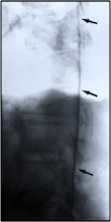Complications while ETT is in place
A) Obstruction of the endotracheal tube (ETT):
Causes:
1-Accumulation of secretions in the tube
2-Kinking of the tube.
B) Misplacement or migration of the ETT:
➧ A common complication and right mainstem intubation has been associated with increased mortality in critically ill patients.
➧ Traditional methods of assuring proper tube position include:
-Observing bilateral chest expansion.
-Auscultation of bilateral breath sounds and the lack of air in the epigastrium.
➧ Unfortunately, none of these methods is reliable, leading to the use of capnography as the current gold standard to detect placement of the tube in the airway and rule out esophageal placement.
➧ Capnography, however, does not detect proximal or distal placement of the ETT within the airway.
C) Respiratory Complications of TI:
1-Dead Space
➧ Tracheal intubation usually results in a small reduction in dead space ventilation (25-75 ml); this reduction is too small to be beneficial in most patients.
2-Airflow Resistance
➧ Resistance to airflow through ETT is significant, particularly at small tube diameters.
➧ Most airflow through ETTs is turbulent. The resistance to flow is therefore proportional to the fifth power of the radius. This can result in marked differences in the pressure necessary to cause airflow depending on the internal diameter of the ETT and the flow rate required.
3-Airway Resistance
➧ Intubation also causes an increase in the lower airway resistance in most people as a result of parasympathetic activation of airway smooth muscle. Generally, the increase in lower airway resistance is not clinically significant.
4-Bronchospasm
➧ TI can trigger severe bronchospasm. Interestingly, only one-half of the patients in whom bronchospasm occurred had a previous history of bronchial asthma or pulmonary disease.
➧ Preoperative inhaled β-agonists such as albuterol as well as anticholinergic agents may prevent bronchospasm in patients with reactive airway disease.
➧ Inhaled/IV β-agonists, anticholinergic agents such as glycopyrrolate, and an increase in the level of inhaled anesthetic agents; all have been used intraoperatively to treat bronchospasm.
➧ In some instances, the tracheal tube must be removed before the bronchospasm will stop.
5-Cough
➧ ETT results in reduced cough efficiency and, if humidification is not provided, drying of the upper airway.
6-PEEP
➧ The presence of ETT through the glottis reduces the small positive pressure or "auto-PEEP" caused by the resistance of air flowing through the glottis. This loss of PEEP may reduce the functional residual capacity in some patients in respiratory failure dependent on "auto-PEEP" for oxygenation.
7-Respiratory Mucosa
➧ The presence of an artificial airway leads to functional and morphologic changes in the respiratory mucosa due to the loss of the humidification, warming, and filtering effects of the upper airway (especially the nasopharynx). In the long term, this may result in squamous metaplasia and granulation tissue formation.
Read more ☛ Hemodynamic effects of Laryngoscopy and TI
Read more ☛ Traumatic Complications of TI



































